So basically i have created an application that renders a curve in a 2D-Dimension (X and Y). This application also uses a haptic device, which is represented as a cursor inside of the frame where the curve is also rendered.
The only thing i want to achieve is to map the y-axis of my projection to my z-axis of the haptic workspace of my haptic device. So basically i want to mantain the logic of the curve and cursor rendering and only change the used axis for my haptic workspace. I used this question: Swap axis y and z
as a guidance. Practically i just have to use glRotatef(90, 1, 0, 0) to achieve what i want. I tried rotating only the projection matrix of my haptic workspace, but this sadly doesnt work for me.
This is how my normal curve looks:

Those are the results, while trying different options:

This is my code
reshapeCallback:
void reshapeCallback(int width, int height) {
glViewport(0, 0, width, height);
glMatrixMode(GL_PROJECTION);
glLoadIdentity();
glOrtho(minX, maxX, minY, maxY, -1, 11);
// glRotatef(90, 1, 0, 0) [4th Try]
glMatrixMode(GL_MODELVIEW);
glLoadIdentity();
// glRotatef(90, 1, 0, 0) [5th Try]
updateWorkspace();
}
updateWorkspace():
void updateWorkspace() {
GLdouble modelview[16];
GLdouble projection[16];
GLint viewport[4];
glGetDoublev(GL_MODELVIEW_MATRIX, modelview);
//glRotatef(90, 1, 0, 0) [2nd try]
glGetDoublev(GL_PROJECTION_MATRIX, projection);
//glRotatef(90, 1, 0, 0) [1st try]
glGetIntegerv(GL_VIEWPORT, viewport);
hlMatrixMode(HL_TOUCHWORKSPACE);
hlLoadIdentity();
//glRotatef(90, 1, 0, 0) [3rd try]
// Fit haptic workspace to view volume.
hluFitWorkspace(projection);
// Compute cursor scale.
gCursorScale = hluScreenToModelScale(modelview, projection, viewport);
gCursorScale *= CURSOR_SIZE_PIXELS;
}
drawLine():
void drawLine() {
static GLuint displayList = 0;
if (displayList)
{
glCallList(displayList);
}
else
{
displayList = glGenLists(1);
glNewList(displayList, GL_COMPILE_AND_EXECUTE);
glPushAttrib(GL_ENABLE_BIT | GL_LIGHTING_BIT);
glDisable(GL_LIGHTING);
glLineWidth(2.0);
glBegin(GL_LINE_STRIP);
for (int i = 0; i < vertices.size(); i += 2) {
glVertex2f(vertices[i], vertices[i + 1]);
}
glEnd();
glPopAttrib();
glEndList();
}
}
I numerated the tries of glRotatef() for different positions. I hope someone can give me a hint where my thought process went wrong.
